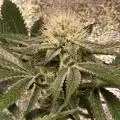The Grow Awards 2026 🏆 

























Likes
Comments
Share


@Zzenith
Follow
Welcome to the week 6
Day 37
Did some LST, a bit, and normal level defoliation, tho I removed lots of leaves.
I think I will defoliate it once more in a week or so.
I will check on her in couple hours and post "after after" photo.
Day 41
I can smell her sweet smell already. It's unbelievably sweet. But I really got the issue with carbon filter and smell right now. I need to stock up some more Ona Gel, carbon filter is expired, replacing it now will be very difficult if not impossible without damaging the plant...
Likes
10
Share


@AsNoriu
Follow
Day 102 since seed touched soil. Still 3g of phosphorus and mycorrhizae to pot, once a week. Green sensation is now 1ml/L , will use same doze till the end. Epsom salt 100 ppm. Girl is flying, got funky purple tint, havent seen it in other diaries of this strain.
This grow is very complicated, in basement, so humidity is very high, have 3 oscillation fans running non stop, plus extraction fan on 70%. I did not one grow with such high RH , hopefully this will go smooth too !
Happy Growing !!!
Likes
35
Share


@Eryan
Follow
Day 49 - Clearly she's starting to get to the end of the life-cycle. The nutrient reserves are being used up in the leaves, although I also suspect a bit of nutrient lockout as well. Today only gave PH'ed water. After taking another look at the trichomes today, I'm starting to wonder if she really is ready for harvest yet or not 😅 I guess I'll take another video in a few days and see how they look then. The pistils are curling in though now, so that's one sign that harvest is getting closer.
Day 53 - Watered again today; she was a little droopy 😳 PH was about 6.05
And took another video of the trichomes...a good one this time. And what do you know...plenty of the trichomes still look clear AF, although I do notice some amber ones. Going to wait until at least next week for sure now to harvest.
Likes
12
Share


@OGbros
Follow
the roots broke the plastic basket😱
Very strong genetic, very recommended👽
Likes
22
Share


@bypado_farm
Follow
Day 69:
Watered each plant with 1.5L with nuts
1379 ppm, 2951us/cm, 2.9 EC (1 purple punch, wedding Cheesecake)
1391 ppm, 2959 us/cm, 2.9 EC (gorilla cookies) 1L
319 ppm, 678 us/cm 0.6 EC (3 strawberry banana and 2 purple punch) (2L each)
3 different feedings for the 10 plants
Still flushing all the strawberry banana and 2 purple punch with flawless finisher, 2ml per L. (1st week flawless finisher, 2L each, 2nd week clear water, 150L each pH tap water)
Day 71:
I've been struggling with the humidity, always around 70%, I can't turn the lights off at the moment. I lost one of the main fans during 2 days, and I found mold on all the tops on one purple punch and on the smaller strawberry banana as well. First timing having this issue! High humidity plus not enough air circulation equals this. Mistakes happen for a reason. Need to start rethinking my whole air circulation, exaustor, fans, etc etc. I removed the infected buds, I used a magnified glass to help me do the job better. I did everything like the book. Already have 3 fans on the tent, let's see how it goes. Humidity between 65-75%
Day 73:
Watered each plant with 1.5L with nuts
1458 ppm, 3101us/cm, 3.1 EC (2 wedding Cheesecake and 1 gorilla cookies)
283 ppm, 602 us/cm 0.6 EC (3 strawberry banana, 3 purple punch and 1 wedding Cheesecake) (2L each)
2 different feedings for the 10 plants
Still flushing, 1st week flawless finisher, 2L each, 2nd week clear water, 150L each pH tap water)
Everything running smooth, they are starting to show the colors from the flush I've been doing.
Day 75:
Watered each plant with 1.5L with nuts
290 ppm, 617 us/cm 0.6 EC (3 strawberry banana, 3 purple punch and 3 wedding Cheesecake) (2L each)
Day 77:
Watered each plant with 1.5L with nuts
1811 ppm, 3810 us/cm, 3.8 EC (gorilla cookies)
253 ppm, 538 us/cm 0.5 EC (3 strawberry banana, 3 purple punch and 3 wedding Cheesecake) (2L each)
Still flushing... Going to cut some of them this week.
Likes
9
Share


@Lifesgarden420
Follow
Another beautiful lady chopped and drying with that whole plant hang really looking forward to these but they are so Frosty and so dense thank you for these amazing genetic and this amazing contest you guys really know how to bring the world together thank you again 💚👑👊🏼😎💨🏼
Likes
7
Share


@Xpie77
Follow
During the second week of flowering for Purple Kush, here’s what you can expect and steps to ensure a successful grow:
Plant Development
1. Bud Formation: Small pre-flower buds (calyxes) will begin forming along the nodes. Pistils (white hairs) may be visible.
2. Stretch Phase: The plant will still be stretching, potentially doubling in height as it transitions into full flowering mode.
Care Tips
1. Lighting: Ensure a consistent 12/12 light cycle. Use strong flowering lights (HPS, LED) with red spectrum dominance.
2. Nutrients: Transition to flowering nutrients with a higher phosphorus (P) and potassium (K) ratio. Avoid overfeeding nitrogen to prevent leafy growth.
Example: 1-3-2 NPK ratio is common in flowering.
3. Watering: Keep watering consistent but avoid overwatering. Allow slight drying of the topsoil between watering.
4. Temperature & Humidity:
Ideal temperature: 65–80°F (18–26°C).
Humidity: Reduce to 40–50% to prevent mold/mildew as buds develop.
Training
If you’re doing any low-stress training (LST), finish this early to avoid stressing the plant during full bloom.
Remove any dying or large fan leaves blocking bud sites to improve light penetration.
Monitoring
Watch for pests like spider mites and early signs of mold or nutrient deficiencies.
Look for healthy, vibrant leaves and steady growth in bud sites.
By week 2, your Purple Kush should show noticeable progression in flower development, setting you up for a good yield in the weeks to come.
Likes
24
Share


@DevokeOG
Follow
Week 7 the start of flowing and my ph and TDS meters have arrived which should make things a little easier for me to understand what is going on, I had changed the light schedule last week to 12-12 because I wasn’t really sure that it was an Autoflower or not due to it being bagseed but it looks as tho the pistols are getting bigger now that I have 🍁✌️🏻.
Likes
14
Share


@Auto_lover
Follow
Flowers are coming along nicely.end of week swelling starting to incre
Likes
1
Share


@Nickeluring
Follow
We are trying to survive the heat wave we have here at the moment. Hopefully an extra dose of silicone will aid a bit...
Both plants look very well. The mainlined plant is slightly taller at 58 cm, while plant 1 measures 54 cm.
Likes
9
Share


@Rizik86
Follow
Day 58 - Checked PPM 1,300.
Day 59 - Checked PPM 1,300. Got lucky <<<
Day 60 - Checked PPM 830. buds are swelling.
Day 61 - Added 10 mL of 10 mL of CalMag Micro Grow and Bloom. Added 5 mL of Bud Candy Sensizym Big Bud Nirvana Rhino Skin and B-52. PPM is 1,560.
Day 63 - Checked PPM 667.
Likes
6
Share


@Growmie95
Follow
Harvest day for Purple Ghost Candy. Big buds bit not so much frost and smell.. had a mutation and probably unlucky pheno.
One more week for super lemon haze. Looking super healthy and frosty.
Likes
26
Share


@SmokeableHobby
Follow
1/17 - Day 62 / Day 35 Flower
Pots felt dry so decided to give them about a half gallon of spring water each. This wasn't enough to induce runoff. Will save that for a bigger watering later this week. Nutrient issues continue to persist.
****************************************************
1/19 - Day 64/ Day 37 Flower - Feeding day
Pots were feeling dry again. After about a week of laying off the nutrients following the flush, I gave them a feeding today with their watering. In retrospect, I probably shouldn't have waited this long to re-introduce nutrients as some of the lag in recovery is probably due to the fact that I flushed all of the food.
The feeding solution consisted of the following:
- 1 gallon distilled water
- 5ml of FF Tiger Bloom (1/2 dose)
- 10ml of FF Big Bloom (2/3 dose)
Adjusted the solution to the following conditions before feeding:
- pH: 6.5
- TDS: 303ppm
- EC: .6
I gave each of the 5 gallon pots about a half gallon each of the solution, followed by enough spring water to induce runoff (approximately another half gallon). I tested the runoff for both of my 5 gallons and returned the following readings;
Z51:
- pH: 6.4
- TDS: 649ppm
- EC: 1.3
Z52:
- pH: 6.2
- TDS: 669ppm
- EC: 1.3
I was encouraged that both plants are close to being within my ideal range and hopefully this means that they will start to show signs of recovery in the next week.
****************************************************
1/21 - Day 66 / Day 39 Flower
I'm growing in an attic space and we've had a drop in temperature over the last couple days, my heating system was working overtime and more heat was rising into the space. I woke up today and the temp in my grow tent was registering in at 87F. I decided to play around with my temperature threshold on my fan controller, reducing the max heat threshold to 80 from 85. What I didn't account for was that I had a low humidity threshold of 30% (which I assumed meant that that fan would stop running if it hit this point). It turns out that my fan actually kicks ON when it hits that threshold... As a result. my fan was short cycling through the night where it would turn on when the heat exceeded 80 (causing humidity to decrease) then turn on again when it hit my low humidity threshold - creating wide swings in my temp and humidity. I'll tell you what, if I don't produce any viable bud this grow, I can honestly say I made up for the loss based on the education I've received.
The nutrient deficiency issues are still present but don't appear to be getting worse. The leaves on my Z51 are pretty pale, it's clear they are starving for nitrogen but I am reluctant to try and address issue at this point. I'm planning 2 more light feedings over the next two weeks so hopefully this will be enough to get them to harvest.
****************************************************
Day 1/22 - Day 67/Day 40 Flower
My girls are really starting to frost up and the colas feel noticeable more dense by the day. I would have thought that the smell would have been stronger by now. Not sure if this is a consequence of my carbon filter doing such a good job or whether the buds are having developmental issues. When I get up close and smell the buds, I get a faint aroma but not the strong sweet and gassy smells that I've read about on other journals.
I watered the 5 gallons today with a gallon of spring water each. My soil is not as airy as it once was and has started to cake up around the roots. I do my best to try and loosen up the dirt, usually to no avail.
I was short for time so I didn't have a chance to test the runoff.




























